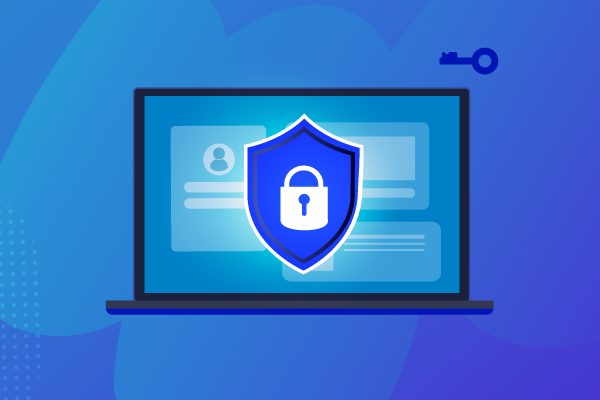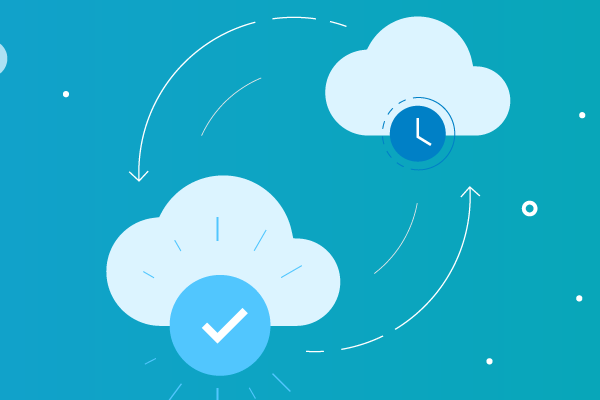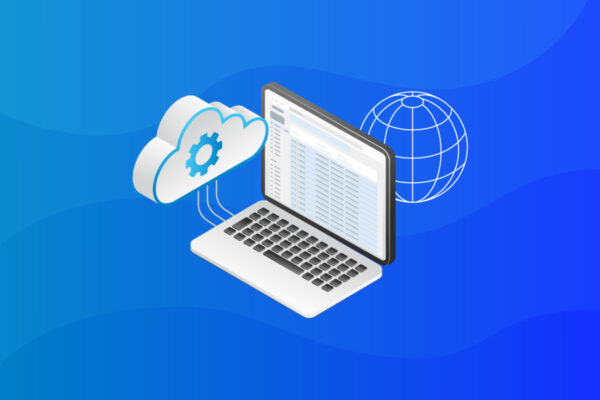Backup and business continuity: What’s the difference?
Uninterrupted business operations area top priority for organizations of every size. But in today’s always-on world, it doesn’t take much to throw operations off track. Hardware failures, natural disasters, cyberattacks or even simple human errors can result in major data loss and unexpected downtime. The fallout? Lost productivity, lost revenue, and in some cases, long-lasting reputational damage.
Whether you’re an IT leader or an MSP, your job is to keep systems running, no matter what. But here’s the question: Is having backups enough to make that happen? The short answer is no. Backup is only the beginning. To ensure true operational resilience, you need a comprehensive business continuity and disaster recovery (BCDR) strategy that’s built for speed, reliability and flexibility when things go wrong.
In this blog, we break down the differences between backup and business continuity, and why the two are often misunderstood. You’ll learn how backup and business continuity work together, why backup alone is only a piece of the puzzle and how to build a comprehensive BCDR strategy to keep operations running. We’ll also offer practical guidance and show you how Datto BCDR solutions can help you achieve true business continuity.
Backup vs. business continuity
Backup and business continuity are often lumped together in conversations about IT resilience. While closely related, they serve very different purposes. Understanding the difference — and how they work together — is essential to keeping your business running in the face of unexpected disruptions.
It’s important to understand each concept separately to learn how they fit into your resilience strategy.
What is backup?
Backup is the process of creating copies of your data, systems and configurations so you can recover them if they’re lost, deleted or damaged. Think of it as your safety net. Whether it’s an accidental file deletion, a ransomware attack or a corrupted database, having a recent backup means you can restore what was lost.
For example, imagine an employee accidentally deletes an important client contract stored on a shared drive. Without a backup, that file is gone. With a backup, you can retrieve it in minutes and get back to work.
But backups aren’t just about having a copy; they need to be reliable as well. That means backups should run automatically on a set schedule, be stored in secure, geographically separate locations, and be protected against unauthorized access. A strong backup solution should let you recover anything from a single file to an entire server environment, depending on what’s needed.
What is business continuity?
Business continuity is the strategy and planning that ensures your business can continue operating during and after an unexpected event. It goes far beyond just backing up data. The goal is to keep people, processes and technology aligned so that critical services can stay up and running or get back online quickly.
Let’s say a hurricane takes out your on-site servers. Even if you have backups, do you have a plan for restoring operations elsewhere? Can employees access systems remotely? How fast can you spin up a new environment? Business continuity planning answers those questions.
An effective business continuity strategy includes several key elements: risk assessments to identify threats, impact analyses to understand consequences, clearly defined roles and responsibilities, communication protocols and regular testing of recovery plans. It’s a living strategy that’s always evolving to reflect changes in your business and threat landscape.
Is backup part of business continuity?
Yes, backup is a critical part of any business continuity and disaster recovery strategy. But by itself, it’s not enough. Think of backup as the foundation: it’s essential, but it won’t hold up the entire structure on its own.
A complete BCDR strategy combines data backup with disaster recovery planning, system failover capabilities, communication protocols and operational procedures. Backup answers the question, “Can we recover our data?” Meanwhile, BCDR answers a much bigger one: “Can we keep operating while we recover, and how fast can we bounce back?”
For example, if a ransomware attack locks your files, a solid backup can help you restore them. But without a tested recovery process, off-site infrastructure or a plan for keeping employees productive during downtime, your business still suffers major disruption. That’s where BCDR comes in. It covers the full lifecycle of disruption response, from detection to recovery and beyond.
Let’s break it down further with a side-by-side comparison:
| Backup | Business Continuity | |
| Purpose and focus | Protects data by creating restorable copies that can be recovered after loss, corruption or deletion. | Keeps critical business functions operational during and after disruptions, minimizing downtime and maintaining service availability. |
| Scope of operation | Narrow in scope; systematically copies and stores data in secure locations. | Broad and strategic; encompasses people, processes, technology, communications and facilities to ensure full organizational resilience. |
| Response to disruption | Supports recovery by allowing access to previous versions of data, but does not guarantee quick restoration of business operations. | Enables rapid response through planned procedures, failover systems and continuity protocols that ensure operations can resume with minimal interruption. |
| Protection approach and technology in use | Uses file-level or image-based backups stored locally or in the cloud to protect data and enable restoration. | Employs integrated BCDR solutions with local and cloud virtualization for instant recovery and seamless continuity. |
Fig 1: Backup vs. business continuity
How backup supports business continuity planning
While a backup alone won’t keep your business running during a major disruption, it does play a foundational role in your ability to recover. The key is recognizing that backup is only one layer of a broader BCDR strategy.
BCDR builds on the basics of backup to deliver complete IT resilience: it enables fast recovery, reduces downtime and keeps your systems — and people — moving when it matters most.
Let’s explore how backup contributes to business continuity, and the critical factors that turn a simple backup strategy into a strong, tested BCDR solution.
Calculating RTO and RPO
When thinking about continuity, two metrics matter more than anything: recovery time objective (RTO) and recovery point objective (RPO).
- RTO is how long your business can afford to be offline. It defines your acceptable downtime threshold.
- RPO is how much data your business can afford to lose. It determines how recent your last viable backup needs to be.
The shorter your RTO and RPO, the more resilient your organization. But hitting those targets requires thoughtful planning, tested infrastructure and the right backup technology behind it.
Let’s say a logistics company operating a 24/7 distribution network experiences a server failure. If its RTO is two hours, but restoration takes eight, orders are delayed, customers walk away and revenue slips. Likewise, if its RPO is 15 minutes, but backups only run every 12 hours, it has lost a huge amount of transactional data.

Fig 2: Total cost of downtime
To see how much downtime could actually cost your business — or your clients’ — use Datto’s Recovery Time & Downtime Cost Calculator. The numbers may surprise you.
Going beyond file-level backup
In the event of a major disruption, recovering just the files only gets your data back, but doesn’t bring your business back online. That’s where image-based backup makes a difference. It captures the entire system: files, applications, configurations and the operating system, allowing you to restore a complete working environment, not just a folder of documents.
With image-based backups, recovery becomes fast, complete and seamless, which is crucial for real business continuity.
Protecting against local disaster
If your backups are stored only on-site, they’re just as vulnerable as the systems they protect. For instance, let’s say a wildfire destroys a company’s office, including its local servers and backup devices. If everything were stored locally, there’s nothing to restore from. That’s why off-site and cloud-based backups are essential.
Better yet, BCDR solutions allow you to failover to the cloud, spinning up systems remotely so employees can continue working, even if the physical office is out of commission.
Accounting for cyberthreats
Modern ransomware attacks target your backup infrastructure along with your production environment. That’s why modern BCDR strategies include immutable backups that can’t be modified, encrypted or deleted, even by internal users or malicious actors.
Immutable backups typically have write-once read-many (WORM) storage that makes them immune to ransomware, human error or insider threats. It ensures that even if your live environment is compromised, your recovery point remains untouched.
Ensuring recoverability
A backup that can’t be restored is as good as no backup at all. The most resilient organizations don’t just back up their data; they also test those backups regularly.
Notably, automated backup verification helps eliminate uncertainty. It regularly checks whether backup images can boot successfully, whether files are intact and whether systems can be restored to a functional state. This proactive approach drastically reduces the risk of discovering a corrupted or incomplete backup during a real emergency.
Regular testing also allows businesses to confirm that recovery times align with their RTOs and that data loss is within acceptable RPO thresholds. When integrated with alerting and reporting, this level of oversight ensures any backup issues are caught and addressed early, long before they become business disruptions.
Go from backup to business continuity with Datto BCDR
Today’s threat landscape makes it clear that having just a backup isn’t enough. To keep operations running during outages, attacks or disasters, businesses must adopt a business continuity mindset. That means going beyond data protection to ensure systems, applications and workflows can be recovered quickly, without missing a beat.
Datto’s BCDR solutions are built for this exact purpose. They go beyond traditional backup by delivering advanced tools that help businesses recover faster, minimize downtime and maintain operational continuity when it matters most.
Here’s how Datto BCDR helps you achieve complete resilience:
- Instant virtualization, locally or in the cloud: Quickly spin up entire systems on-site on Datto appliances or in the immutable Datto BCDR cloud to restore operations within minutes.
- Ransomware resilience: Immutable backups combined with built-in ransomware detection help prevent data loss and ensure clean, uncompromised restore points.
- Automated screenshot and application verification: Every backup is automatically tested with visual confirmation that systems and services are bootable and ready to recover anytime.
- Flexible recovery options: Restore files, applications or entire systems based on the scenario — on-site, in the cloud or hybrid — giving you full control over recovery workflows.
With Datto BCDR, you can ensure business continuity across any scenario and confidently meet recovery objectives without the complexity. Explore how Datto BCDR helps keep your business running no matter what. Learn more about Datto BCDR solutions.
Want a deeper understanding of how intelligent business continuity compares to traditional backup? Download the Backup vs. Intelligent Business Continuity eBook and discover what it really takes to build resilience in today’s environment.



